
Pedagogical Practices: Design and Validation of SOCME-10 Rubric in Teachers who have Recently Entered Basic Education
[Prácticas pedagógicas: diseño y validación de la rúbrica SOCME-10 en profesores de reciente ingreso a la educación básica]
Sergio Tobón1, Luis Gibran Juárez-Hernández1, Sergio R. Herrera-Meza1, and Cesar Núñez2
1Centro Universitario CIFE, Cuernavaca, Mexico; 2Universidad de Medell├şn, Colombia
https://doi.org/10.5093/psed2021a13
Received 20 April 2020, Accepted 18 January 2021
Abstract
This study was intended to validate a rubric to assess pedagogical practices SOCME 10 in teachers who have recently gone into teaching service in Mexico based on socioformation. Its content validity was determined from a 21 expert evaluation. Highly satisfactory levels of suitability and understandability were obtained in each of the 10 pedagogical practices contained in the instrument (Aiken’s V > .80). Afterward, the rubric was administered to 532 Mexican teachers recently recruited for the public education service. Participants expressed high levels of suitability, understandability, and satisfaction concerning the instrument. According to the theoretical rationale, exploratory and confirmatory factor analyses determined the single-factor nature of the instrument. The factor was identified as “mediation of problem-based training, collaboration, and inclusion.” Instrument reliability was Cronbach’s alpha (.86). It is concluded that SOCME 10 possesses high levels of content and construct validity, as well as reliability for the target population.
Resumen
Este estudio tuvo como propósito validar la rúbrica SOCME-10 para evaluar las prácticas pedagógicas con base en la socioformación, en profesores que recientemente ingresaron al servicio educativo público de México. Inicialmente, se determinó la validez de contenido a partir de una evaluación de 21 expertos. Al respecto, en cada una de las 10 prácticas pedagógicas establecidas en la rúbrica SOCME-10 se obtuvieron valores satisfactorios en la V de Aiken (V >.80) en pertinencia y comprensión. Posteriormente, se administró la rúbrica a 532 profesores mexicanos que recientemente ingresaron al servicio público educativo. En general, los participantes evaluaron la rúbrica con un nivel adecuado de pertinencia, comprensión y satisfacción. Los análisis factoriales exploratorio y confirmatorio confirmaron la existencia de un único factor en la rúbrica, denominado “mediación de la formación basada en problemas, la colaboración y la inclusión”. La confiabilidad medida por el alfa de Cronbach fue de .86. Se concluye que la rúbrica SOCME-10 posee validez de contenido y de constructo, así como confiabilidad para el grupo abordado.
Palabras clave
Prácticas pedagógicas, Enfoque socioformativo, Rúbrica, ProfesoresKeywords
Pedagogical practices, Socioformative approach, Rubric, TeachersCite this article as: Tobón, S., Juárez-Hernández, L. G., Herrera-Meza, S. R., and Núñez, C. (2021). Pedagogical Practices: Design and Validation of SOCME-10 Rubric in Teachers who have Recently Entered Basic Education. Psicolog├şa Educativa, 27(2), 155 - 165. https://doi.org/10.5093/psed2021a13
stobon5@gmail.com Correspondencia: stobon5@gmail.com (S. Tob├│n)While modern society is nowadays considered as an information society, we are still faced with achieving what is called a knowledge society that encourages collaboration between communities and organizations. Such a society’s purpose should be to improve living standards by managing and co-creating knowledge from different sources, based on information and communication technologies. Therefore, it becomes necessary to provide the means for a socioformative learning approach to nurture citizens, teams, and communities engaged with solving social issues and improving living standards. This should be based on an ethical life plan, entrepreneurship, collaborative work, the co-creation of knowledge, metacognition, and complex thinking (Tobón et al., 2018). The purpose of the socioformative approach is to transform traditional—and ineffective—methods into suitable pedagogical practices designed for human and social development which promote both inclusion (Castro-Rubilar et al., 2017) and creativity (Karwowski & Lebuda, 2017). The core ideas of the socioformative approach are 1) project-based work intended to solve problems in a real context and contribute to improving living conditions; 2) progressive strengthening of an ethical life plan, as in a community contribution towards sustainable development by implementing such universal values as responsibility, respect, equity, and honorability; 3) development of complex thinking skills, such as systemic thinking, flexibility, and metanoia; 4) collaborative knowledge building through searching, systematizing, critically analyzing, creating, adapting, and implementing different types of knowledge; and 5) collaborative work focusing on achieving common goals related to social development and the articulation of different people’s actions (Fuentes-Arismendi & Malagón-Micán, 2019; Prado, 2018). After years of research on teachers’ performance in terms of competencies, there has been a recent shift toward the concept of practices (Bolívar, 2019). A practice represents a more concrete realization of what a competency expresses. Practices are comprised of knowledge, abilities, and values (Gómez-Hurtado, 2013) but include other elements, such as goals aspiration, decision making, teachers’ professional identity, and emotional management (Bolívar & Ritacco, 2016; Burbules, 2020). Specific practices are not only more visible than competencies, but might also patently show how performance is innovative, sustainable, replicable, and suitable for specific needs depending on the context (Noman et al., 2018; Reyes, 2017). Furthermore, practices are without negative connotations (as is the case with competencies), especially within certain social sectors which link this term to neoliberalism (Angulo & Redon, 2011; Pérez et al., 2019). Therefore, pedagogical practices are defined as actions that help students fulfill their learning process through different teaching methods and learning strategies (Álvarez-Álvarez, 2015). Due to their impact on the learning process, they must be regularly tested (Chrispeels et al., 2007). From a socioformative approach, pedagogical practices are actions through which the students learn problem-solving indirect contexts to improve living conditions, and strive toward sustainability and inclusion by collaborating with everybody both in school and around it: teachers, authorities, parents, communities, and other students (Tobón et al., 2018). This implies the collaborative creation and management of knowledge-based on valid sources. This represents a significative change to the concept of pedagogical practices, traditionally taken as simple tasks to be done by teachers. They are now understood as actions that impact citizens’ formation toward a knowledge society (Mansell, 2015). For a better understanding of pedagogical practices and their relationship with social challenges, it is possible to distinguish four levels. Level I refers to general pedagogical practices that must be executed by every teacher and are more related to what every teacher ordinarily does, with no regard for any specific educational model or an ideal society to achieve. These practices are, for example, lesson planning, teaching, tutoring, learning resources managing, question answering, helping students to solve problems, and learning assessment. At this level, what is important is that teachers accomplish their duties no matter how much students learn. Level II practices are those based on autonomous, meaningful, and reflexive learning, as the ones promoted by Ausubel’s (1963) meaningful learning and constructivism (Piaget, 1953). This level represents a step forward from Level I, as long as these practices are intended to lead learning toward situations that enclose real significance to students. Level III refers to pedagogical practices based on creativity, pair work, collaboration, the linkage between technology and learning at different environments, as proposed by approaches such as socioconstructivism (Vygotsky, 1978), connectivism (Siemens, 2006), and invisible learning (Cobo & Moravec, 2011). At this level, the focus goes beyond the student himself and widens so to contemplate how context and social environment determine student’s learning. Level IV refers to pedagogical practices directed towards sustainable social development (Lee & Ávila García, 2019; Servín-Ramírez & Vázquez Sánchez, 2019) and are decisively oriented to train students to solve real-life problems and impact positively in every effort society makes in favor of environmental care, biodiversity conservation, as well as fostering a solidarity culture. The latter is something Level III practices do not consider at all. Level IV practices have been proposed by socioformation, for instance, real-life problem solving sustainably, inclusion, learning through service, human talent development through formative projects, transversality, and ethical project of life. Each of the four levels mentioned before includes those basic practices in previous levels. Therefore, in Level IV there are pedagogical practices from levels I, II, and III, while problems society faces nowadays, such as climate change, fake news, violence, and COVID-19 pandemic, are faced only through new pedagogical practices like those in Level IV. The assessment of pedagogical practices has received much academic attention (Bell et al., 2012; Gettinger et al., 2011; Hamre & Pianta, 2010; Seidman et al., 2014; UNESCO, 2017); however, the majority of these studies have focused on Levels I and II. One of the most common instruments is the Classroom Assessment Scoring System (CLASS™) (Hamre et al., 2013; Pianta, 2011), a tool to observe teachers’ actions inside the classroom according to ten activity dimensions each teacher should perform within three latent factors: emotional support, instructive support, and classroom management (Hafen et al., 2015). Another assessment instrument, the Stallings Observation System (World Bank, 2015), focuses on observing classroom activities for short periods, especially time management and student learning activities. The Teacher Instructional Practices and Processes System (TIPPS) (Seidman et al., 2014) enables an 18-dimension assessment on how teachers work inside the classroom, evaluating certain actions regarding meaningful learning, such as “teacher employs students’ ideas and interests” or “teacher connects syllabus contents with students’ everyday life experiences”. In recent years, new instruments have been developed and validated in Mexico to assess the pedagogical practices of basic education teachers (Arregui et al., 2018; Gutiérrez-Anguiano & Chaparro, 2020). These instruments have been adapted from Danielson’s Framework of Teaching (Danielson, 2013)—a very extensive four-dimension rubric type (planning and preparation, classroom environment, instruction, and professional responsibilities) taken as a basis for several studies in the USA (Finster & Milanowsky, 2018; Liu et al., 2019). Generally speaking, it could be said that CLASS, the Stallings Observation System, and Danielson’s Framework of Teaching simply evaluate what every teacher does (Level I) without taking suitability and actual impact on pedagogic work into account. TIPPS, however, approaches meaningful learning actions (within Level II), but without considering specifically how teachers manage issues like problem-solving, inclusion, and project-based work (i.e., Level IV practices). In an Ibero-American context, certain assessment instruments have been proposed—most notably in universities—the majority of which focus on Levels II and III. Pérez et al. (2016) designed and validated the Teaching Practices Questionnaire (TPQ), a Likert type scale, to assess how frequently certain teaching activities are performed. These activities are organized regarding the following factors: 1) student-centered teaching; 2) teaching qualification; 3) process evaluation; 4) dialogic interaction; 5) instruction-centered teaching; and 6) technological resources employment. This instrument belongs to Level II due to its inclusion of student-centered teaching and meaningful learning, although it considers many Level I issues. Lizasoain-Hernández et al. (2017) designed an 18-item instrument to evaluate higher education teachers with a 3-factor structure: planning (items 1-5), process and development of teaching activities (items 6-16), and outcomes (items 17-18). It includes issues related to Level II, such as formative assessment, teamwork, autonomous learning, and the fostering of critical and reflective thinking. Another instrument, classified as Level II, is the Teaching Strategies for Meaningful Learning Scale (EEDAS, to use its Spanish acronym) (Méndez & González, 2011). It evaluates 12 dimensions: previous information generating activity; introductory focal activity; positive-negative-interesting; guided discussion; goals and intentions; key diagram; conceptual mapping; prior answer-question-later answer; what I know–what I want to know–what I learned; summary table; analogies; and summary. Although these instruments are closely related to meaningful learning, they do not consider how teachers include context problem-solving activities—or any other similar actions—to promote student participation in enhancing living conditions or environmental sustainability. At Level III, an instrument designed by Barahona (2004) can be used to assess teachers’ creativity and teaching style. It has a 6-level scale and contains 48 items—none of which relate to real problem-solving, environmental care, or the building of better living conditions. There are few instruments at Level IV, but the Inclusive Pedagogical Practices Scale by Carrillo et al., (2018) for elementary and high school is worth examining. It has satisfactory values of reliability, content validity, and construct validity. It is structured by 45 items which range from totally agree (TA) to totally disagree (TD). Other instruments exist which focus on certain practices related to specific educational aspects, such as promoting good human interaction and socioemotional abilities (Moafian et al., 2019; Laudadío & Mazzitelli, 2018), ensuring inclusive education for talented and gifted children (Dağlıoğlu et al., 2019), and fostering humanistic, equitable, ecological, and socially just environments (Nava, et al., 2018). While the majority of these instruments were developed and validated through rigorous and accurate validation processes, core instructional practices are excluded. As such, there are no instruments at Level IV which focus on pedagogical practices to resolve real problems or foster an ethical life plan with transversality and innovation. Existing instruments to assess pedagogical practices are, in general, either scales or registers of observation. While these can be useful as they allow a quick and easy evaluation of what occurs within the classroom, interpretations for each level may differ between evaluators (Marin-García & Santandreu-Mascarell, 2015). Moreover, scales do not allow for a precise grading of the exact level at which a specific practice is performed by teachers regarding knowledge society and sustainable social development purposes (USAID, 2010). It is, therefore, necessary to design other types of instruments (rubrics, for instance) as they facilitate teachers’ self-assessment of the level at which they are performing and the identification of improvement opportunities and needs in terms of pedagogical practices. To fulfill the existing lack of instruments with which to assess Level IV pedagogical practices, a Pedagogical Practices Rubric SOCME-10 has recently been designed (Tobón et al, 2018) using the socioformative approach (see Appendix). This instrument is intended to enable self-assessment of teachers regarding 10 core pedagogical practices that contribute to socially sustainable development in the knowledge society. It has criterion validity for high school teachers in Mexico from an exploratory factor analysis that gave a single factor solution and a high-reliability level. However, as yet there is no valid evidence of SOCME-10 for entry-level teachers of basic education. Such groups—having little teaching experience—need tools to self-assess their pedagogical practices to improve their teaching and consolidate their professional profile. According to several studies, a lack of support for novice teachers produces a significant rate of dropouts (Feroli, 2015; López et al., 2018). Socioformation is designed to help young and new teachers strengthen the pedagogical practices required to participate in the worldwide social sustainable development effort (Cummings et al., 2018; De Freitas-Fernández, 2019; Juárez-Hernández et al., 2019). This paper hopes that SOCME-10 could benefit this purpose. Therefore the objectives of this study were: 1) to review items and descriptors or the rubric SOCME 10 to adapt them for new entered teachers to the public education professional service in Mexico; 2) to determine the instrument content validity through evaluation by judges; 3) to identify understandability quality, suitability, and level of satisfaction on the instrument from users opinion; 4) to establish instrument construct validity; and 5) to determine rubric reliability. Participants In this study, 532 basic education teachers from Mexico participated, from 101 schools, who had between 0 and 2 years of having been hired in the official sector, all of them teaching elementary education groups. Age was between 20 and 56 years old (mean = 29.77, SD = 7.8); 82% were female and 19.8% male; 25.7% taught kindergarten, 40.5%, primary, and 33.8% secondary school. Most of the teachers worked in schools located in urban areas (74.6%), while 13.9% worked in rural (13.9%) or suburbian schools (11.5%). The sample was non-probabilistic, and teachers participated voluntarily, after accepting an invitation e-mail through which they where informed about de purpose of the study and the structure of the instrument, as well as its suitability to assess their teaching practices according to knowledge society. Besides, several virtual meetings were held to inform and motivate teachers to participate in the research. The teachers came from the states of San Luis de Potosí, Chihuahua, Guanajuato, Quintana Roo, and Yucatán. The instrument was administered online between January and July 2019. Instrument This study presents the validation process of SOCME-10 (Tobón et al., 2008) (see Appendix), a rubric type instrument whose purposes are to 1) help teachers determine the degree to which they possess a set of key pedagogical practices to educate students according to the challenges of socially sustainable development and 2) enable teachers to identify both their achievements and areas for improvement to reach to the maximum level of such practices. The rubric was validated through an exploratory study with 167 high school teachers (Tobon et al., 2018) and from the study it is shown a single factor and reliability of .89 Cronbach’s alpha (Nunnally & Bernstein, 1994). However, there is no evidence about its validity and reliability for basic education new-entered teachers. This led to the decision of doing a new validity and reliability study including the instrument evaluation by experts and a pilot testing of its suitability. Table 1 contains an overview of the 10 pedagogical practices SOCME-10 focuses on, as well as the assessment questions put forward to the teachers. Each question is scored on five performance levels according to the socioformative taxonomy (Prado, 2018): preformal (very low), receptive (low), resolutive (medium), autonomous (medium-high), and strategic (very high). Each of these levels provides teachers with descriptors to identify their status at the moment of self-assessment. SOCME-10 practices do not refer to everyday instructional activities or teaching competencies; it focuses, rather, on those key actions teachers must perform to educate citizens for the knowledge society, such as problem-solving, ethical project of life, collaborative work, and transdisciplinarity—all within inclusive frameworks. While SOCME-10 does not contain any specific practice for inclusion, this element is inherent to every indicator at its highest level. Ethical Aspects Ethical aspects were accomplished: 1) every participant was informed about the study purposes and signed an on-line letter of consent; 2) participants could have quit if they decided to; 3) personal information, such as contact data and test responses, was protected under the personal data protection Mexican laws (Diario Oficial de la Federación, 2010); and 4) participants had access to their responses once they completed the rubric. Phase 1. Content Validity Study SOCME-10 was sent to 21 judges to determine its content validity (Table 2). Judges assessed indicators and descriptors suitability and understandability, through a four-level scale from very low (1) to very high (4). They also provide a level of satisfaction about the instrument through a five-level scale from very low (1) to very high (5). The judge’s responses were tested using Aiken’s V and their 95% confidence intervals. Acceptance criterion was established for items rated Aiken’s V>0.80 and lower confidence limit over 0.6 (Penfield & Giacobbi, 2004). Judges were also asked for wording remarks. Phase 2. Pilot Test After the content validity analysis, a pilot test was held by administering SOCME-10 to a group of 25 basic education teachers who had less than 2 years of professional experience); 88% were female and 12%, male. Their ages went from 25 to 50 years old (mean = 30.44, SD = 5.76). Teachers had an mean of 7.2 of experience in other educational fields (SD = 5.97), and a labor old average of 1.2 as public education teachers after being promoted from the recruiting assessment process. The instrument was administered online. The pilot study was done to determine: 1) level of understanding of instruction; 2) level of understanding of all rubric items and descriptors; 3) suitability and understandability of the whole instrument; and 4) level of satisfaction about the instrument. The first three aspects were assessed through a 4-level Likert type scale, from very low (1) to very high (4). Point 4 was evaluated through a 5-level Likert type scale from very low (1) to very high (5). The level of acceptance for each one of the 5 variables was 3.0. Besides, pilot group members were asked to provide suggestions for possible amendments in items or descriptors; a t-test was used to determine whether each value means differed significantly from the expected means (3.0). Previously, the normality assumption was verified, considering kurtosis and skewness between -2 and +2 as the criterion of accomplishment (Bollen & Long, 1993). Phase 3. Testing of Suitability, Understandability, and Satisfaction Once some amendments were practiced on the SOCME-10 instructions from the suggestions provided by the pilot group, the rubric was administered to the 532 recently recruited basic education teachers sample. All the participants answered a survey to determine the level of suitability, understandability, and satisfaction on the rubric, after having completed it. Scale and statistical analysis and acceptance criteria used in the pilot test were also applied to data obtained in this sample. Phase 4. Construct Validity and Reliability The factorial structure of the instrument was analyzed by two methods: exploratory factor analysis (EFA) and confirmatory factor analysis (CFA). The sample was first randomly divided into two groups of 266 participants. The first group was used for the EFA and the second for the CFA. Initially, skewness and kurtosis were analyzed to verify the adjustment of the items to the normal distribution, establishing as a criterion that the skewness and the kurtosis between -2 and +2 (Bollen & Long, 1993). To conduct the EFA, application assumptions (determinant, KMO, and Bartlet test) were first considered, and the maximum likelihood was chosen as the method of extraction in case normality assumption was fulfilled (Fabrigar et al., 1999). The CFA was subsequently performed, using the maximum likelihood estimation method. The model’s goodness of fit was evaluated using chi-square, chi-square ratio/degrees of freedom, and absolute adjustment indexes (GFI, RMSEA, and RMR), as well as incremental indexes (CFI, TLI). The average variance extracted, and the composite reliability was calculated, considering the threshold value for the former to be greater than .50 (Fornell & Larcker, 1981) and greater than .70 for the latter (Hair et al, 2014). Reliability was also calculated using Cronbach’s alpha (Cronbach, 1951). The software used for the exploratory factor analysis was SPSS V.20 (IBM) and AMOS v.20 (IBM) for the confirmatory factor analysis. Content Validity From Table 3, Aiken’s V values are shown for each of the 10 pedagogical practices SOCME-10 is intended to assess. It can be observed that all 21 judges agreed to consider every item as pertinent and understandable, as long as all of them obtained V values over .80 in suitability and understandability and none of them obtained a value less than .60 in the lower value of the 95% confidence interval. There was also agreement in considering the rubric as a satisfactory instrument for its purposes (mean = 4.2380, Aiken’s V = .80951). So, it can be affirmed that the instrument has content validity. Pilot Test The 25 newly recruited teachers showed scores over the expected means (3.0) in every variable (understandability of instructions, items, and descriptors, suitability, and satisfaction) (Table 4). Suggestions provided by participants were taken into account to get to a clearer formulation of some instructions before it was administered to the target sample. Suitability, Understandability, and Satisfaction The satisfaction survey applied to the 532 teachers sample showed average scores for each variable (suitability, understandability, and general satisfaction) significantly over the expected means (3.0) taken as minimum acceptable (Table 5). Construct Validity and Reliability The data can be assumed to present a normal-like distribution as, according to the analysis, none of the items violated the established criteria of skewness and kurtosis (Table 6). However, a Mardia test showed clear violations of multivariate normality (critical ratio = 15.6). Although some studies have shown that similar values of multivariate kurtosis may not affect the results of factor analysis to a greater extent (see, for example, Gao et al., 2008), it was decided that weighted least squares method, considered more suitable for non-normal samples, be used (Nalbantoğlu-Yılmaz, 2019). From the EFA, the correlation matrix showed a determinant close to zero (.037), and the adequacy of the data was positive (KMO = .928, χ2 = 1239.951, p < .001). A single factor solution was found, which explained more than 53.7% of the variance (Table 7). In this factor, all items were represented with factor loads greater than .60. The results of the CFA revealed a good fit of the model (Table 8). Specifically, χ2, the ratio χ2/df, the absolute adjustment indices (GFI, SRMR, and RMSA), and incremental indices (CFI, TLI) showed an optimal value. The reliability, as measured by Cronbach’s alpha (α = .86) and composite reliability (CR = .88), was optimal (Table 9). It is important to note that all items presented values in standardized factor loads greater than .50 (Table 9). The average variance extracted was .42. The final model is shown in Figure 1. In Figure 1, an association between the errors of variables 4 (formation of universal values and an ethical life plan) and 5 (assertive communication) was observed to improve the model goodness-of-fit measures. This can be related to the dynamics used by teachers to promote ethical reflection, which is usually based on expressing their experiences in the class group, which necessarily implies learning to speak, listen, and tolerate diverse opinions. In other words, although both dimensions are theoretically very different, the pedagogical practices used to address them are similar. The study evidence that the Rubric of Pedagogical Practices from a socioformative approach (SOCME-10) has adequate levels of content validity—as shown by the results of Aiken’s V coefficient (the values of suitability, understandability, and satisfaction of the rubric as rated by experts were above .80). The examiners were teachers highly experienced in didactics, learning assessment processes, design of evaluation instruments, and the socioformative approach. The analysis of construct validity through the EFA indicates the correspondence with the theoretical model (stipulated as one-dimensional). As such, the only identified factor served to explain over 45% of the variance and integrated all of the items—highlighting that they all presented factorial loads above the established minimum (FL > .350) (Hair et al., 2014). The above denotes the importance of the expert judgment phase since, as indicated, content validity is an essential component of construct validity (Haynes et al., 1995). The evaluation of the model through the CFA provided elements with which to verify its adjustment to the data since optimal values were presented for the different indicators used (χ2/df, absolute adjustment, and incremental indexes). An important aspect contributed by this analysis is the values of standardized factor loadings (SFL > .50) and Cronbach’s alpha and composite reliability. This allows for the verification of the proposed model’s empirical sustainability. While the average variance extracted (AVE) is relatively low, the data obtained is generally suggestive of the solid psychometric properties of the questionnaire. There are two important considerations here: first, item factor weights and high levels of reliability allow us to trust instrument’s working despite the low AVE (this criterion has been used in previous studies; see, for example, Igbaria et al., 1995); second, the characteristics of the instrument—based on a rubric of pedagogical practices—imply that the items are inevitably broader than a typical item on a psychometric scale, which may serve to explain the low value of AVE. Delving into this aspect, Fornell and Larcker (1981), as well as Hair et al. (2014), consider that to demonstrate the existence of convergent validity it must be met that average variance extracted is greater than .50, standardized factorial load of each item is greater than .50, and that composite reliability is greater than .70. Following the results presented in this study, it could be argued that there is no convergent validity since the stipulated value of average variance extracted is not met. However, Moral de la Rubia (2019) states that the greater the number of items that make up a factor, the more the convergent validity measured through average variance extracted deteriorates, for which he recommends considering a mean extracted variance value adjusted to the number of items, in conjunction with the stipulated values for standardized factor loads and composite reliability. According to this proposal, the average variance extracted adjusted to the number of items in the present study is acceptable if it is greater than .300 and composite reliability greater than .80 to demonstrate an acceptable level of convergent validity. For both aspects, as well as related standardized factor loads, these guidelines are met, therefore it can be indicated that there is convergent validity, meaning that the construct is adequately measured by the proposed indicators (Cheung & Wang, 2017). In any case, the results were considered satisfactory for the first version of the questionnaire, although future studies could address reported weaknesses. The single factor SOCME-10 evaluates (identified through EFA and CFA) has been labeled “mediation of problem-based training, collaboration, and inclusion.” Considering teachers’ work, each of the 10 practices contributes to this factor. Socioformation maintains that mediation goes above and beyond teaching or instruction (Brito-Lara et al., 2019), and consists of accompanying and supporting students so they learn problem-solving skills while working within an inclusive, collaborative, and ethical framework (Bautista et al., 2019). This framework implies participating in every social effort to improve living conditions and better care for the environment and natural biodiversity. Users rated the rubric with a mean over expected (3.0) in the variables of suitability, understandability, and satisfaction. These aspects are rarely evaluated in similar instruments (see, for instance, Abós-Catalán et al., 2018; Gutiérrez-Anguiano & Chaparro, 2020), which means a relevant contribution of this study to the area. In this regard, it has been possible to establish measuring satisfaction about a scales is important for an assessment tool designing process (Seidman et al., 2018), because, although instruments show high validity and reliability values, frequently they are not suitable for users. Consequently, it can be concluded that SOCME-10 is an instrument that users validate as acceptable to be employed to help everyday practice, self-assessment, and continuous training of new teachers who join teaching service. Several tools designed for the assessment of pedagogical practices have been mentioned in the relevant literature, which can be classified according to the level of articulation with challenges related to a knowledge society (Mansell, 2015). For instance, at Level I (regarding what every teacher must do) a significative number of instruments can be found (Hamre et al., 2013; Pianta, 2006; World Bank, 2015); at Level II (focusing meaningful and autonomous learning), only Seidman et al.’s (2014); at Level III (including creativity as well as social relationship), Barahona’s (2004); and at Level IV (highlighting the determining actions required to achieve sustainable social development, such as creativity and inclusion), Carrillo et al.’s (2018). Very few instruments belong to Level IV. Consequently, SOCME-10 rubric can contribute to the increase of instruments in this area that guide teachers in the transformation of education according to the challenges of sustainable social development (Luna-Nemecio, 2019). SOCME-10 rubric contains some innovative elements regarding the construct it evaluates. For example, it takes practices as units of analysis, which is a more visible, concrete, and integrative professional trait to be assessed (Burbules, 2020; Pagés & Parcerisa, 2018). It also focuses on those actions essential to preparing citizens for a knowledge society, such as problem-solving (Hernández et al., 2018; Safiee et al., 2018), collaboration (Vázquez et al., 2017); values, an ethical life plan (Bautista et al., 2019; Prado, 2018), an interdisciplinary approach (Botero, 2008; Colombo & Alves, 2017; Díaz, 2010), creativity (Csikszentmihalyi, 2014; Karwowski & Lebuda, 2017), and metacognitive evaluation (Tobón et al., 2018). Furthermore, this rubric has several innovative aspects: 1) the application of a socioformative taxonomy in the development of descriptors (Sánchez-Contreras, 2019), which provides teachers with a more precise and detailed tool to evaluate—and improve—their pedagogical practices (Seidman, 2012); 2) pedagogical practices are evaluated within a range of five levels, from a traditional content-focused practice to a more innovative educational practice, articulated with current and future social challenges (Mansell, 2015); and 3) the rubric seeks to contribute to training people committed to sustainable social development (Anastacio, 2020; Cummings et al., 2018; De Freitas-Fernández, 2019; Juárez-Hernández et al., 2018) and who have a key role in communities around the world—an objective that should guide current education and which is rarely evaluated in current scales of pedagogical practices. As the present study was exploratory, it must be confirmed by applying the same tool in similar populations. Moreover, other aspects of its validity should be determined, such as consistency over time and concurrent and divergent validity of components with other tools or items already proven to be valid regarding pedagogical practices. Although the present study originally contemplated a factorial invariance measure, the characteristics of the sample used, with a high prevalence of women, did not allow this analysis to be carried out. Future studies with gender-balanced samples should also address this issue. The rubric shows validity and reliability only for people who freshly got this occupation of teaching in Mexican schools; this means that its scope is rather limited and cannot be generalized to every basic education teacher. For this reason, further study is needed to determine its validity and reliability for other teachers despite the number of years in professional service. Another limitation of this study is that SOCME-10 psychometric properties as a rubric were not contrasted to those of other types of instruments, such as scales, which is an issue that might be deeply studied (Marin-Garcia et al., 2015). Conflict of Interest The authors of this article declare no conflict of interest. Cite this article as: Tobón, S., Juárez-Hernández, L. G., Herrera-Meza, S. R., & Núñez C. (2021). Pedagogical practices: Design and validation of SOCME-10 rubric in teachers who have recently entered basic education. Psicología Educativa, 27(2), 155-165. https://doi.org/10.5093/psed2021a13 Referencias |
Cite this article as: Tobón, S., Juárez-Hernández, L. G., Herrera-Meza, S. R., and Núñez, C. (2021). Pedagogical Practices: Design and Validation of SOCME-10 Rubric in Teachers who have Recently Entered Basic Education. Psicolog├şa Educativa, 27(2), 155 - 165. https://doi.org/10.5093/psed2021a13
stobon5@gmail.com Correspondencia: stobon5@gmail.com (S. Tob├│n)Copyright © 2024. Colegio Oficial de la Psicología de Madrid



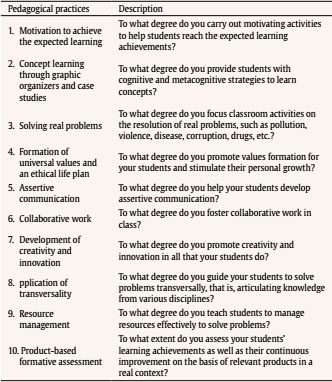
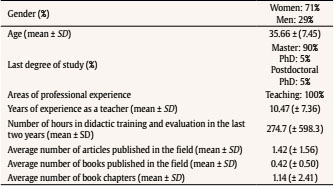
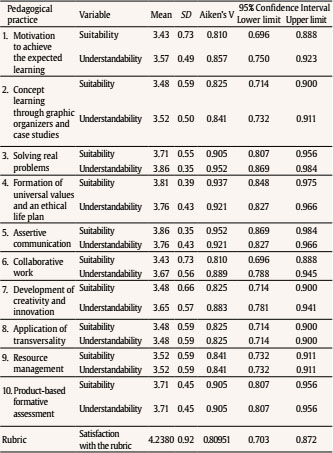
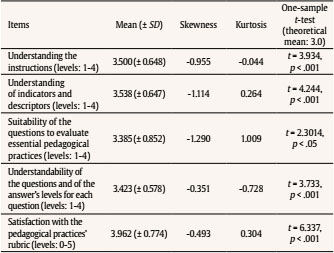
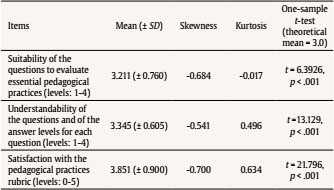
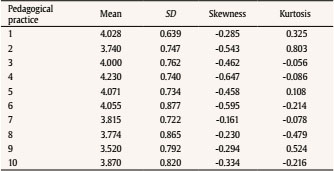


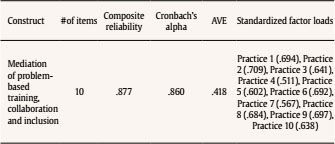
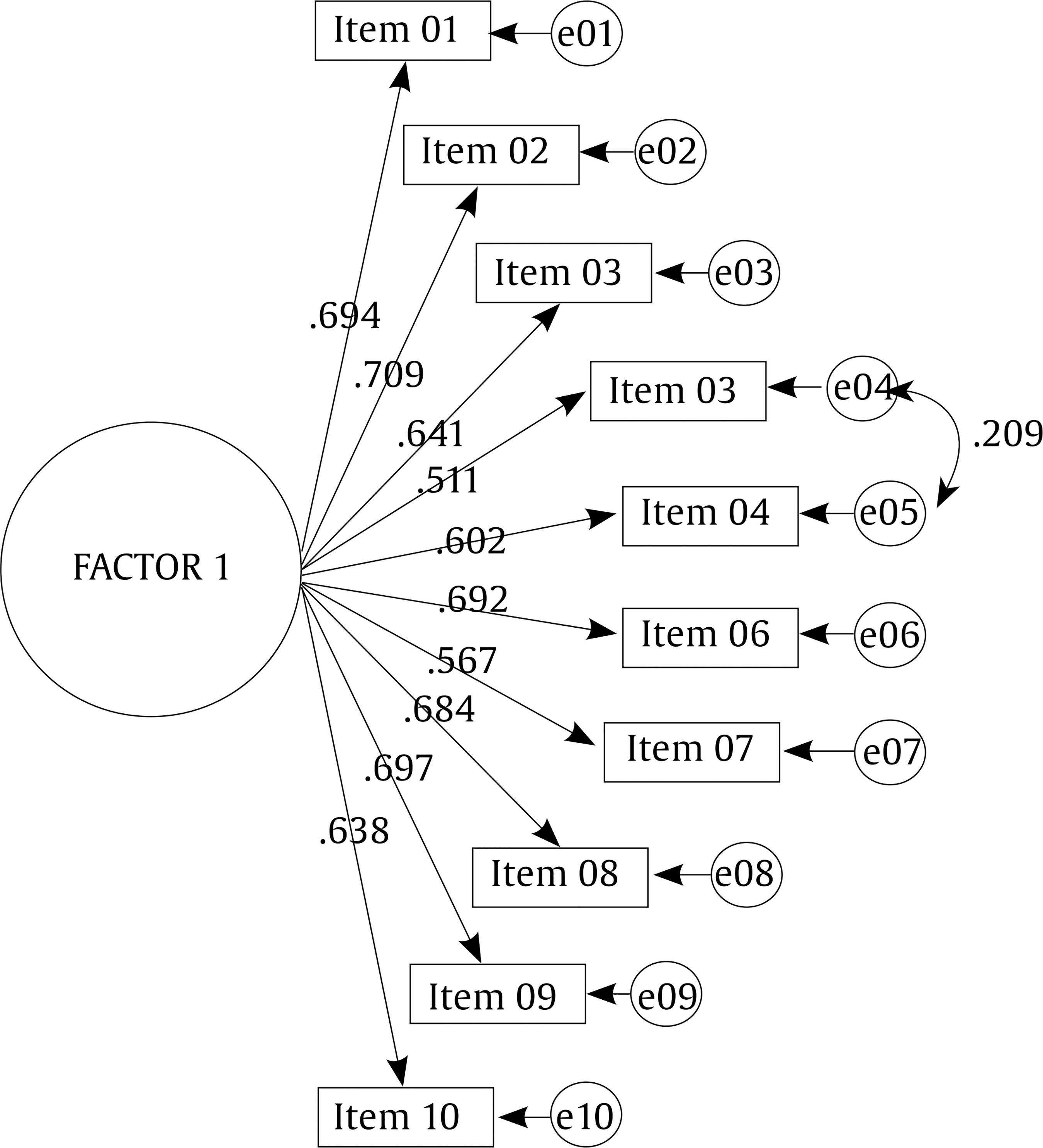
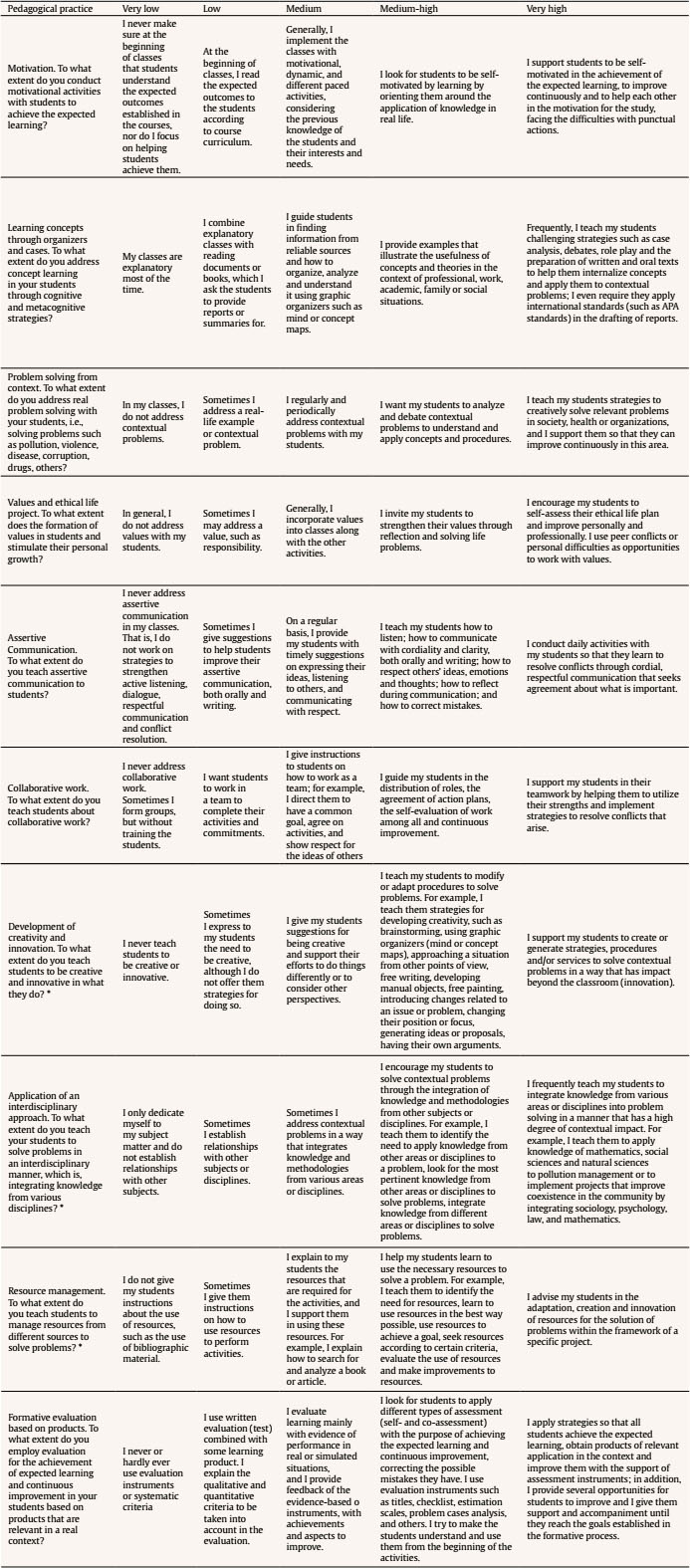






 e-PUB
e-PUB CrossRef
CrossRef JATS
JATS







